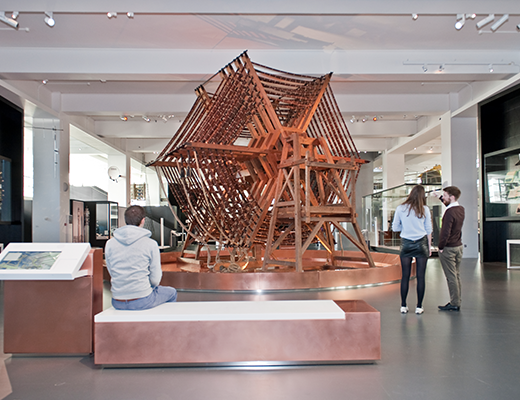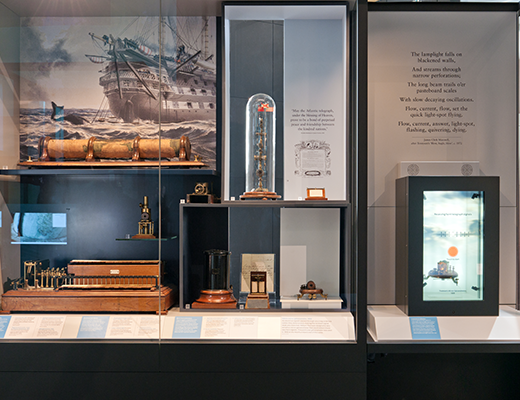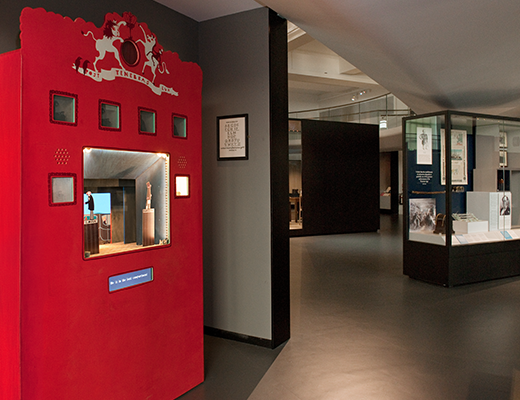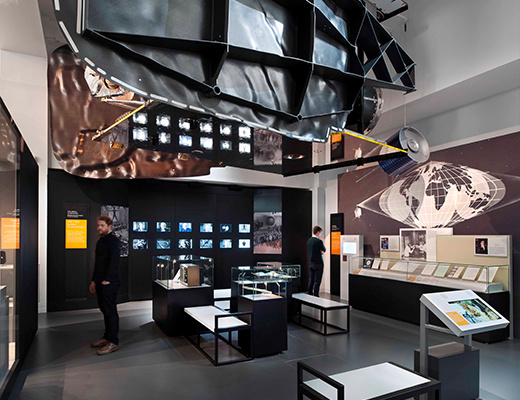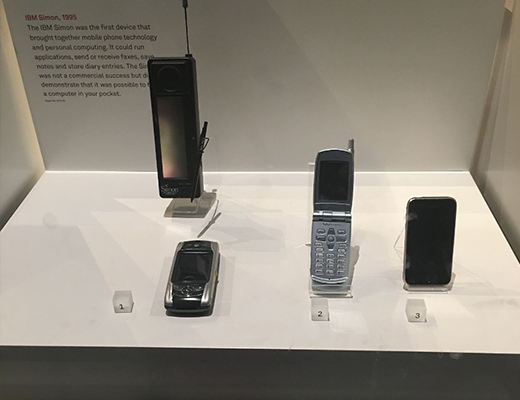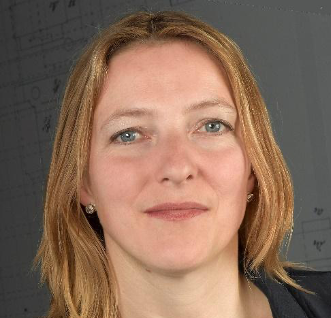Prof Tilly Blyth, Professor and Head of Museum Studies at Leicester University, UK
If you don’t know where you have come from, you don’t know where you are going. – – Maya Angelou
I have been fortunate in my career to be able to combine all of my key interests into one coherent whole- science and technology, the history of people and cultures, and the humanising influence and creativity of the arts.
I began my academic studies in sciences, completing a degree in physics and working on a PhD with BT. From that point on I remained fascinated by the potential of digital technology and soon moved to a digital design agency, Illumina Digital, where we combined interactive design, software development and editorial and production skills, enabling the delivery of innovative solutions for a wide range of media, government education departments and cultural institutions such as museums.
It was a natural progression for me to take up a position at the Science Museum in London, where for over twenty years I built on these various experiences. As Lead Curator of the Information Age Gallery I developed the strategy for one of the most important computing, telecommunications and television collections in the world, delivering a gallery that, as one journalist described it “gives the sector the story of its history and its future”. Its aim was to tell the stories of technological transformation through the experience of those who made, used and developed them. Later I became Head of Collections and Principal Curator at the Science Museum and I went on to build a Curatorial, Research, Library and Archive team that delivered many stunning galleries and award-winning exhibitions, on subjects as varied as Robots, the prophet of the computer age Ada Lovelace, codebreaker Alan Turing, and the history of the UK intelligence service, GCHQ.
One of the key aims of the Information Age Gallery is to inform and excite everyone, in particular the digital generation, about the rapid advance in information and communications technology, but to see this history through the experience of change for each new generation. I wanted to bring in the voices of the users, as well as the inventors, to reflect the range of people involved in the development of a technology. I didn’t want visitors to see these technologies in isolation, but to understand technological transformation as part of a broader set of social, economic and personal networks. I and my colleagues are thrilled with the reception of the Gallery by the public, who continue to share our enthusiasm for the stories and objects on display and who gain a renewed insight into the importance of information and digital technology to everyone in all walks of life.
Now, after twenty years at the Science Museum, I have once again taken on a new challenge as Head of the Department of Museum Studies at the University of Leicester in the UK. Here we deliver outstanding research and excellent postgraduate teaching incorporating theoretical, historical and practical study that focus on the changing role and value of museums and cultural institutions, as they navigate what it means to provide cultural value, commentary and connection in the 21st century. This work is also at the intersection between innovation, technology, cultural heritage and sociology, broadening students’ appreciation of the inter-relationships of these disciplines.
My message to the digital generation is to follow your own interests and seek out areas where you can explore how to use both technology and the humanities to enact change and bring about a better future. We can no longer see technological development in isolation from society, and whilst new technologies such as AI and the metaverse present fantastic opportunities, they also reflect the biases and inequities of the world we live in, so we need to work to understand, address and improve that.
The Information Age Science Museum London UK
Our messages – from the mundane to the memorable – can be counted, compressed and reduced to fundamental ‘bits’. This is information. The UK Science Museum’s exhibition Information Age1, of which I was the lead curator, told the story of 200 years of information and telecommunication networks. Across six networks, it revealed the hidden infrastructure and devices that have allowed us to send more information further and faster than ever before. Through 21 transforming moments, it presented the extraordinary people who have created, used and been affected by each new wave of technology.
The following is a summary of some key milestones in the development of the Information Age in Britain and around the world, to remind us all of the incredible advances that have been made in such a short span of human history.
Aerial tuning inductor from Rugby Radio Station
This enormous structure resembles a gigantic hexagonal spider’s web and it stood at the heart of the exhibition space. On 1 January 1926, Rugby Radio Station began sending messages to the world. Its very-long-wave, low-frequency radio signals could bend around the curvature of the Earth. Long wavelengths can also penetrate water, so Rugby Radio Station became a hub for encrypted military communications with ships and submarines.
1. The Cable
Telegraph networks send information from point to point in the form of electrical pulses. The telegraph could send information at high speed, over long distances, giving rise to the first global communication network, and radically shrinking our world. Its impact on society was every bit as significant as the development of later information networks, such as the internet.
- In 1858 the continents of Europe and North America were linked for the first time by a submarine telegraph cable. Just three weeks later the cable failed and it took eight more years of research and investment before telegraph signals at last crossed the Atlantic. It meant that messages could be sent across the vast ocean in minutes rather than weeks. The Great Eastern was the world’s largest passenger ship but it was commercially unsuccessful. Later it was fitted with both paddle and screw engines to become an ideal cable-layer.
- William Thomson designed an extremely sensitive mirror galvanometer in 1858 to detect faint telegraph signals.
- A practical electric telegraph was first demonstrated in
- London in 1837. Telegraph and railway networks spread in parallel, bringing the need for a commonly agreed time reference. From the 1850s, time signals sent from Greenwich were used to set clocks all over Britain. By 1884 one-hour time zones were agreed for the globe.
- In 1843 William Cooke installed an electric telegraph alongside the Great Western Railway between Paddington and Slough. On 1 January 1845 this instrument sent a message declaring that suspected murderer William Tawell had boarded a train. Tawell was later arrested and hanged.
The telegraph: the nervous system of commerce
The development of printing telegraphs accelerated the rate at which information travelled through the network. In October 1929 telegraph lines were overwhelmed with information and stock tickers ran several hours late. The chaos of the Wall Street Crash showed the reliance of business on communication links.
- Sending information on stock and share prices was one of the earliest uses of the electric telegraph. The ‘stock ticker’ installed in offices printed out details of share price movements in a form easily understood with a few minutes’ training.
- The dramatic rescue of over 700 survivors from the Titanic disaster in April 1912 was made possible thanks to wireless telegraphy. The event widely publicised the advantages of the new technology.
- By 1910 nearly all passenger ships on the north Atlantic run had wireless telegraphy installed. The Marconi Company hired its equipment to shipowners and provided a trained operator. Morse code was used, but the range was still restricted and messages from mid-ocean had to be relayed to shore by other ships.
2. The Broadcast
Television and radio networks use radio waves to carry information from a transmitter to many receivers. Information is transmitted simultaneously, connecting millions of people watching or listening to the same programme at the same time. Digital broadcast technologies use cable, satellite or internet links to distribute huge quantities of information more efficiently. By providing choice and control, they transformed the way listeners and viewers interact with radio and television.
- In the 1920s amateur radio operators used skills learnt during the First World War to develop small communities of experimenters and listeners. In 1922 the BBC transmitted its first radio programme, marking the beginnings of official state broadcasting, and a new era for listeners at home.
- On a foggy November night in 1922, the words ‘This is 2LO calling’ announced the arrival of the BBC. The BBC’s first transmitter, 2LO transmitted words and music from Marconi House near The Strand and to listeners at home.
On the box
In the interwar years many radio enthusiasts began to experiment with television. By 1953 families and communities gathered around newly purchased television sets to watch the coronation of Elizabeth II. For the first time more people watched an event unfold on their television screen than listened to it on the radio.
- The early television receiving apparatus used by John Logie Baird in 1926 in a demonstration at the Royal Institution, London.
- In 2005 Britain’s communications regulator, Ofcom, announced that a digital switchover to digital television would commence and that the last analogue television transmitter would be switched off in 2012. A huge engineering challenge was undertaken to upgrade Britain’s television transmitters. In parallel, a public relations plan was implemented to ensure that users did not lose their television signal.
- In 2002 owners of the British television transmitter network collaborated with broadcasters to form Freeview. Purchasing a Freeview set-top box allowed viewers to watch new channels free of charge. The numbers of digital television viewers rose rapidly.
3. The Exchange
The telephone converts speech into electrical signals, carried through wires and switched across the network by telephone exchanges. Subsequent telephone networks transmit digital signals over fibre optic cables, radio, microwave or satellite links. The telephone gave rise to new forms of behaviour and social etiquette, transforming working lives and relationships. As a teacher of deaf people, Alexander Graham Bell experimented with transmitting speech electrically.
Telephones entered homes and workplaces in the early 1880s, transforming social and business relationships. Picking up the receiver connected callers to a switchboard operator, usually a young woman. From 1912 automatic exchanges made it possible for callers to make their own connections.
- Operators at a manual switchboard2 spoke directly to local callers, connecting them to other users by plugging a cord into one of the sockets or ‘jacks’ in the upper part of the switchboard, or forwarding the call to another exchange using other connections.
- Electromechanical exchange equipment could be used to serve a very small number or thousands of people. This private automatic exchange from Holmsted Manor, a converted country house in Sussex, connected only about 20 offices.
- On 26 May 1957 the American singer Paul Robeson’s distinctive bass-baritone voice filled St Pancras Town Hall in London. Yet he was in New York: the new transatlantic telephone cable, TAT-1, carried his voice across the ocean.
- The first transatlantic telephone cable (TAT-1) provided cheaper and better-quality calls between Britain and America. Submerged repeaters boosted the electrical signals travelling through the cable. Rigid electronic repeaters were laid between Newfoundland and Nova Scotia. Another part of TAT-1 connected the cable to Oban, Scotland.
- In 1953 Chad Varah, Rector of St Stephen Walbrook in London, invited the ‘suicidal and despairing’ to telephone and talk about their distress. The phone number was widely publicised and volunteers listened 24 hours a day, every day. The foundation of the Samaritans heralded a new use of the telephone, unanticipated by its early pioneers.
4. The Constellation
Satellite networks relay information between Earth and space. Using super-high-frequency waves, they deliver voice, image and data to parts of the world that other communications technologies cannot reach. Although remote in the Earth’s orbit, satellites are intimately connected to people’s lives.
- n 1945 Arthur C Clarke predicted that just three satellites could broadcast television images around the world. Twenty-two years later, Clarke’s prediction became a reality. Combining contributions from 14 countries, the BBC’s ‘Our World’ television programme was broadcast live to millions of viewers.
- In service for only six months, Telstar marked a new era in satellite communication. It transmitted the first live television pictures from the United States to Europe and the first phone call through space.
- NASA’s Landsat 5 took over 2 million pictures of Earth, far exceeding its original three-year mission. Equipped with a range of scanning instruments, Landsat supplied high resolution images and information about our planet for mapping and environmental projects.
- During the first Gulf War in 1991, troops buffeted by sandstorms advanced through an unmapped desert. Coalition forces successfully used emerging satellite navigation technology in the disorientating terrain. The accuracy available to the military was later extended to civilian GPS systems.
- The global positioning system (GPS) is a constellation of satellites, each equipped with an atomic clock, sending accurate time and location information to Earth. The first Block IIF satellite was launched in 2010 as one of 30 satellites in the constellation. During the first Gulf War there were only 14 active GPS satellites in orbit.
- In 2001 Keyhole, a small computer graphics company, launched a product that could seamlessly stitch together satellite images, aerial photography and geopositioning. Users could fly across the world to see amazing detail of distant landscapes. This product became Google Earth, which gave anyone with a computer a personal eye in the sky.
5. The Web
- The Pilot ACE (Automatic Computing Engine) computer of 1950 embodied Alan Turing’s idea of a universal machine that could perform any logical task.
- On 25 July 1973 a computer at University College London sent packets of data across the Atlantic. This was the first international link on the ARPANET network, the forerunner of the internet. In spite of their origins in the closed world of Cold War politics, computer networks rapidly became a tool for open collaboration.
- The first email was sent in 1971 using two PDP-10 computers located side by side and connected through the ARPANET.
- In 1986 Peter Kirstein connected this Cisco router to the fledgling internet. Routers are the gateways which allow information to flow between computers in a network.
- In June 1980 Tim Berners-Lee arrived at CERN, Europe’s centre for particle physics research. CERN was a melting pot of people, ideas and information. Within a decade he devised a tool, called the World Wide Web, to ‘link all the bits of information in every computer at CERN and on the planet’. Sir Tim used a NeXT computer to host the first web page at CERN on 25 December 1990.
- A corkboard server was an essential component of Google’s first search engine. A server responds to requests within a computer network. In 1998 the young company made do with inexpensive materials including off-the-shelf personal computers and thin sheets of corkboard for insulation.
- In the 1970s personal computers arrived. At first these machines were wildly popular with hobbyists who had expertise in electronics, but ordinary home users were put off by having to program them with switches and complex commands. It was not until the introduction of the graphical user interface that they were transformed into accessible tools for everyone.
- In 1983 Apple introduced its first computer with an innovative interface that enabled users to click on recognisable graphic icons and navigate through familiar- sounding pages.
6. The Cell
Mobile networks use a series of base stations arranged in a cellular pattern. As users travel across cell boundaries, their mobile devices are seamlessly transferred to the next base station, keeping them in constant touch. In 1982 the British government licensed two companies, Cellnet and Vodafone, to operate the country’s first cellular phone networks. Engineers raced to build a network from scratch, and within three years they had over half a million subscribers. The mobile phone was a luxury item that slotted neatly into the ‘yuppie’ culture of the mid-1980s.
- Early mobile phones needed large batteries to ensure the signal was powerful enough to communicate with a base station antenna and the first ones were mounted in the central console of a car.
- When Vodafone and Cellnet’s networks launched in 1985, base stations like this were at their heart. The cylinders visible on the right are ‘cavity resonators’. They give a sense of the scale of the network. Each cavity resonator could only support one mobile phone call at a time.
- In Africa, access to modern communications was very limited. Until 1997 few people had access to phones in Cameroon, for example. The land-line network was limited and expensive. From a standing start, mobile phone companies flourished as creative Cameroonians set up businesses giving customers access to handsets and selling discounted call time. Cameroonian entrepreneur Emmanuel Bongsunu ran a mobile phone business from a small call box in Bamenda for over a decade. Its bright colours and strategic roadside location attracted ever more customers.
- From the 1990s new microprocessor technology began to transform mobile phones. No longer simply tools for making calls, they became versatile computing devices. Third-generation mobile networks, launched in the 2000s, transformed the way we generated, consumed and shared data.
- In the 1980s the microprocessor company ARM designed a new kind of RISC (reduced instruction set computing) microprocessor. This required low power, but had high performance. Later versions supported the kind of complicated processing needed for the mobile phone to become a smartphone.
- The IBM Simon was the first device, in 1995, that brought together mobile phone technology and personal computing. It could run applications, send or receive faxes, save notes and store diary entries.
- The Information Age gallery opened in October 2014. It is available online here: https://www.sciencemuseum.org.uk/see-and-do/information-age ↩︎
Tilly Blyth is the Professor of Museum Studies at the University of Leicester, where she brings together sector knowledge with creative practice and academic research, to build a new generation of global museum professionals. Prior to joining academia, Tilly spent over twenty years working with national museums, including the V&A, British Museum and Science Museum. As Head of Collections and Principal Curator at the Science Museum her leadership of the curatorial, research, library and archive teams resulted in stunning new masterplan galleries and a programme of temporary exhibitions, with the Science Museum being declared a winner of the Art Fund Museum of the Year prize in 2020. Tilly is also a trustee of Bletchley Park Trust, an adviser to English Heritage’s Blue Plaques Panel, a member of British Academy of Film and Television Arts (BAFTA) and a fellow of the Royal Society for Arts, Manufactures and Commerce.
